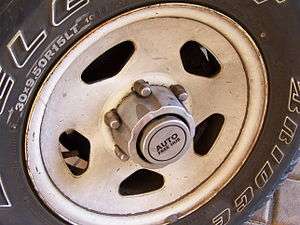Locking hubs

Locking hubs, also known as free wheeling hubs are fitted to some (mainly older) four-wheel drive vehicles, allowing the front wheels to rotate freely when disconnected (unlocked) from the front axle. This is done to reduce the mechanical resistance of the front-drivetrain when four-wheel drive is not in use.[1] The hub is a component where the wheel is directly mounted to, and is outside the axle. The hub, along with the wheel, is designed to engage (lock) onto the axle, to be powered by the drivetrain in four-wheel drive; or the hub can disengage (unlock) from the axle when four-wheel drive is not needed, thus allowing the front wheels to rotate freely within the hub, without being powered by the axle.
Suggested benefits of unlocking hubs for normal road use include better fuel efficiency, quieter operation, less vibration, and lower wear; however, there are no reliable studies to prove these claims. Exactly how great these benefits are is open to debate, with some feeling that they are outweighed by the disadvantages below -
In some vehicles, manual locking hubs are used to engage the front wheels. This requires getting in/out of the vehicle to engage or disengage the front wheels. This may have to be done repeatedly if road conditions are irregular (shift from snow, then dry pavement, then snow again, repeatedly).
In some other vehicles, automatic locking hubs are used which, as the name implies, engage automatically when 4WD is desired. The main advantage is that the driver does not need to leave the vehicle to activate 4WD, or drive the vehicle in 2WD with the front axle disengaged. The disadvantage with this system is that most designs require the vehicle to move some distance (usually a whole wheel turn, often going backwards) after engaging 4WD, in order for the hubs to engage or disengage (in many cases, 4WD can be engaged with the vehicle moving). This might not be possible if the vehicle gets completely stuck before 4WD has been engaged, meaning automatic hubs require more caution on the driver's part.
Exposed hub locks can be broken or damaged by off-road conditions, rendering 4×4 useless and leaving the vehicle stranded. Also, in some axle designs (such as those used on older Land Rovers), the top swivel bearing can become starved for lubrication (which is normally supplied by oil slung up by the rotating axle), unless the hubs are locked every few hundred miles. Also, since locking hubs generally do not require a key to operate, they can be maliciously locked or unlocked by persons other than the vehicle owner.